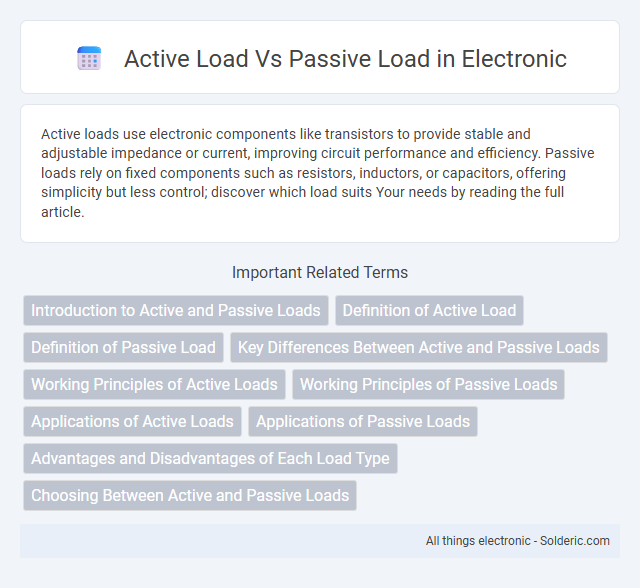Active loads use electronic components like transistors to provide stable and adjustable impedance or current, improving circuit performance and efficiency. Passive loads rely on fixed components such as resistors, inductors, or capacitors, offering simplicity but less control; discover which load suits Your needs by reading the full article.
Comparison Table
| Feature | Active Load | Passive Load |
|---|---|---|
| Definition | Uses active components like transistors to control current | Uses resistors or passive elements to limit or control current |
| Power Consumption | Higher power due to active devices | Lower power, no biasing needed |
| Linearity | Better linearity and gain | Limited linearity, fixed resistance |
| Noise Level | Higher noise due to active components | Lower noise, passive components generate less noise |
| Gain | Higher gain achievable | Gain limited by resistor values |
| Complexity | Higher circuitry complexity | Simple and easy to implement |
| Applications | Used in amplifier circuits for improved performance | Used in biasing and loading where simplicity is critical |
Introduction to Active and Passive Loads
Active loads use electronic components like transistors to provide controlled current or voltage, enabling precise adjustments in circuits and enhancing performance in amplifiers and testing environments. Passive loads consist of resistors, inductors, or capacitors that dissipate energy without requiring power sources, offering simplicity and reliability in basic circuit applications. Understanding the differences between your active and passive load options helps optimize circuit design and achieve desired functionality.
Definition of Active Load
An active load refers to an electronic component, such as a transistor or operational amplifier, that consumes power to maintain a specific current or voltage in a circuit. Unlike passive loads, which rely on resistors or inductors and dissipate energy as heat, active loads dynamically control the load conditions to improve circuit performance and efficiency. This functionality enables enhanced signal amplification, increased linearity, and reduced power consumption in analog and digital circuits.
Definition of Passive Load
A passive load consists of traditional electrical components such as resistors, capacitors, and inductors that do not require an external power source to operate. These components dissipate or store energy without the ability to amplify or generate signals, making them essential for controlling current and voltage in circuits. Your understanding of passive loads helps in designing stable and efficient electrical systems where energy consumption is predictable and manageable.
Key Differences Between Active and Passive Loads
Active loads utilize powered components such as transistors or operational amplifiers to control current flow, enabling dynamic response and amplification. Passive loads consist of non-powered elements like resistors, inductors, or capacitors, providing fixed impedance without energy gain. Key differences include power consumption, control complexity, signal amplification, and frequency response, with active loads offering greater versatility and efficiency in electronic circuits.
Working Principles of Active Loads
Active loads operate using electronic components like transistors or operational amplifiers to replicate resistance with gain, enabling improved signal amplification and linearity in circuits. They dynamically adjust their impedance and provide constant current or voltage conditions, unlike passive loads that solely rely on resistors or inductors. This dynamic behavior enhances performance in amplifiers, oscillators, and sensor applications where precise control of load characteristics is essential.
Working Principles of Passive Loads
Passive loads operate by dissipating electrical energy through resistive, inductive, or capacitive components without requiring external power sources. These loads convert electrical energy into heat or magnetic fields, relying solely on inherent material properties to perform their function. Common examples include resistors, inductors, and capacitors used in circuits to control current, voltage, and phase characteristics.
Applications of Active Loads
Active loads are commonly used in amplifier testing and analog circuit design to simulate realistic load conditions without the power dissipation of passive resistors. They provide precise control over current and voltage, making them ideal for power supply testing, transistor characterization, and impedance matching in communication systems. Your ability to emulate dynamic load behaviors enhances testing accuracy and circuit performance evaluation.
Applications of Passive Loads
Passive loads are widely used in applications such as loudspeakers, antenna matching circuits, and power distribution systems due to their simplicity and reliability. These loads consist of resistors, inductors, and capacitors, enabling stable and predictable performance without requiring external power sources. Your choice of passive loads ensures efficient energy dissipation and minimal signal distortion in various electronic and communication devices.
Advantages and Disadvantages of Each Load Type
Active loads offer precise control, improved frequency response, and reduced distortion, making them ideal for high-fidelity audio and RF applications; however, they require power and can be more complex and costly. Passive loads are simple, reliable, and cost-effective, with no power requirements or noise introduction, but they often suffer from limited bandwidth and less control over impedance characteristics. Understanding your specific circuit needs helps determine whether the dynamic performance of active loads or the straightforward simplicity of passive loads suits your design best.
Choosing Between Active and Passive Loads
Choosing between active and passive loads depends on your circuit's performance requirements and power constraints. Active loads, typically implemented with transistors, provide higher gain, improved linearity, and better frequency response, making them ideal for high-speed or precision applications. Passive loads, such as resistors or inductors, offer simplicity, lower noise, and better power efficiency, which suits low-cost or low-power designs.
active load vs passive load Infographic

 solderic.com
solderic.com